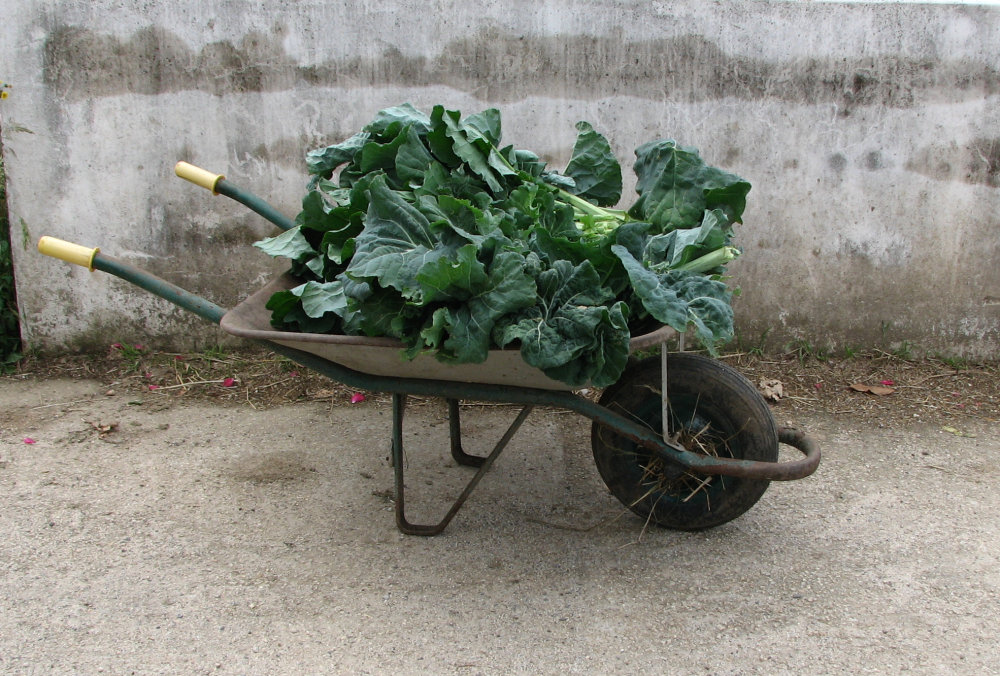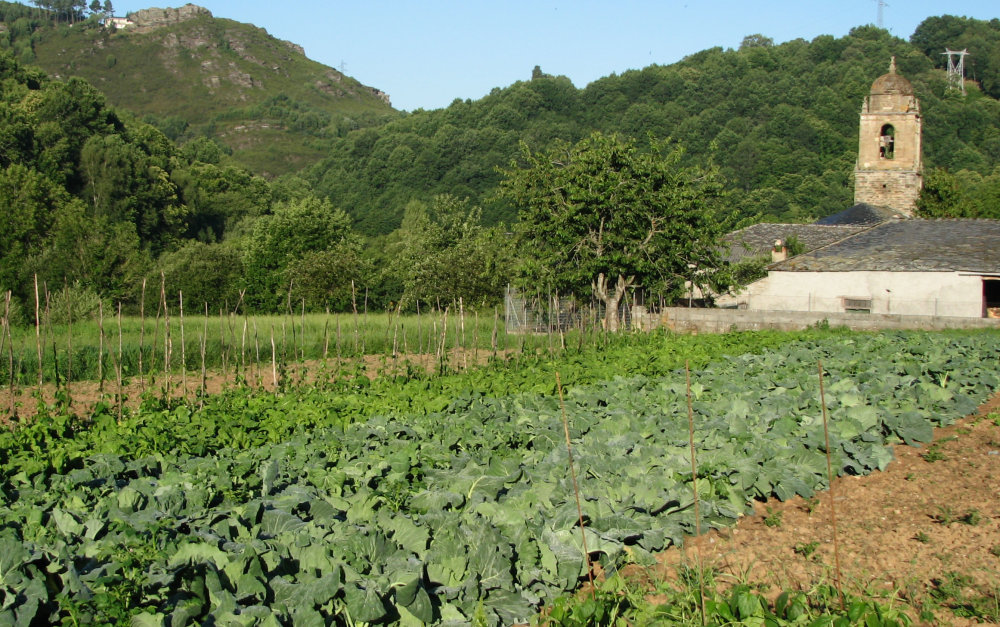Kale is a super-food, or so they tell us. It’s on that list with blueberries, salmon, quinoa and now (yes!!) dark chocolate.
Now I’m not a real cook, but I do like playing in the kitchen, and my first experience with kale chips was a real revelation (thank you, Betsy). The problem is finding kale in Madrid.
Sometimes I can get it at the Vallehermoso market. Then there’s a small fruit-and-veg place in the trendy and health-conscious Chueca neighborhood. There’s even a place not too far from my apartment. But none of these is really reliable, and all require a special and sometimes unsuccessful trip.
It’s different in the north, where kale is food for some kinds of livestock as well as an important ingredient in regional dishes. That includes Galicia, the northwest corner of Spain, where gardens with kale abound along the last kilometers of the Road of St. James (el Camino).
When I say gardens, that can be anything from a two rows to a big field. It’s not unusual to see knee-high kale next to a stalky kale almost two meters high, so tall you’d think it was another plant altogether. I’ve always been curious about that tall kale (Camino pilgrims walking with me also ask), but never had the chance to talk to an expert to get the scoop.
Last month I got my chance during first part of Way-Back Camino, walking the Camino away from Santiago instead of towards Santiago. In a village at the top of a hill on that dang rollercoaster into Portomarin (pilgrims will remember, it’s harder going east!) right on the Camino there was a wheelbarrow piled high with kale and a woman harvesting in her garden. I took a photo of the wheelbarrow as she was coming out with another armful, looking at me with a puzzled expression, um, you like my wheelbarrow?
So we talked about kale , and I got the scoop.
The knee-high kale was planted about three months ago – March or thereabouts – and the tall kale about a year and a half ago; kale can easily live two years and get taller than hers, so tall that you have to pull it way down to harvest the leaves. No, the frost doesn’t kill it, she says it tastes even better after a freeze, something I’ve seen in kale recipes that require frost-nipped kale. (climate note: it does freeze in Galicia, but temps are rarely below freezing for the entire day, and certainly not below 25ºF for any length of time at all).
She told me that caldo gallego is usually made with kale from late spring to fall, and with turnip greens in the winter. (A Galician woman in Madrid told me this can be a family thing, as her family always uses turnip greens).
My expert got the kale scoop too – she was surprised to hear that kale is considered a super-food, and liked the idea of kale chips. She was shocked that kale is hard to find in Madrid, and that one of my sources told me it’s not the season – she indignantly insisted that it is high season for kale, but we concluded that the clueless Madrid vege vendor was thinking hearty soups, not a summer favorite in Madrid where temperatures are often over 90ºF.
We parted after a nice conversation and some good giggles, sort-of friends. This is just the kind of local encounter that I love and seek out whenever possible – next time I walk through her village I’ll be looking for her to say hi and ask if she tried the kale chips.
Spanish language tips:
Kale = berza. Turnip greens = grelos
Caldo gallego: literally Galician broth, though this hearty soup is anything but “broth”.
Spanish slang: coger una berza (catch a kale) = get drunk
Caldo gallego recipes
Caldo gallego is one of those traditional recipes with some basic ingredients and lots of options. Every Galician cook has a recipe, and most cook by eye instead of by a book; if you want to make caldo gallego here are the basic guidelines:
Must have: greens (usually kale or turnip greens, also works with spinach or cabbage or a mixture of greens), potatoes, white beans (some kind about ½ inch long)
Optional: ham, chorizo type sausage, beef, meat stock (meat is not at all necessary to make a fabulous soup). Some people add onion, garlic or chestnuts.
Lovely thing about caldo gallego? There’s no way to make it wrong. Well, it’s not wrong as long as you use the three basic ingredients, that watery potato soup with three beans in Triacastela on my last trip was not caldo gallego. What a disappointment!
If you are a by-eye cook, here’s my unscientific, super-simple method. It’s not 100% authentic but pretty close, easy to do and pretty darn good (I like one-pot meals that don’t need watching!). True cooks who cringe at this method: see real recipes at the end.
Proportion idea per serving (do your own thing if this doesn’t look right): 1 medium white potato, handful uncooked of white beans, about 3 or 4 times volume of potato in uncooked kale. Make extra, this keeps for several days and heats up well.
Remove the big central vein from the kale leaves and tear into pieces, size not real important but thinking of eating ease perhaps double the size of soup spoon is largest reasonable size.
Cut the potatoes into thick slices (chunks are ok too).
In a deep, heavy pot, get the potatoes started in some olive oil. When they’re a little soft add a bit of garlic or onion if you are using. This is a good time to add the chorizo, so the potatoes get the flavor.
Add the soaked white beans and about double water to cover (or a bit more depending on beans, less if beans are pre-cooked canned type).
Add a bit of salt and a sprinkle of pepper (not really in Spanish recipe but tastes good). Another possible addition: sprinkle of Spanish smoked paprika.
Let that mixture do its thing on medium-low heat for a while, add the greens and let it finish cooking. How long? Ummm. Greens need to be totally wilted into the soup, beans done but potatoes not completely mushy. Correct seasoning and serve.
Possible addition: Chestnuts! Peeled and maybe roasted prior to soup (I can get them prepped like this in Madrid). I’ve never had caldo with chestnuts in any restaurants, but saw this in a recipe (now vanished) tried it and it’s great; Galician chestnuts are as famous as Galician potatoes.
A recipe in Spanish
www.recetasderechupete.com/caldo-gallego-receta-tradicional-gallega/4365/
Two recipes in English, they look ok, first more than second
www.tienda.com/recipes/caldogallego.html
http://spanishfood.about.com/od/hotspanishsoups/r/CaldoGallego.htm


